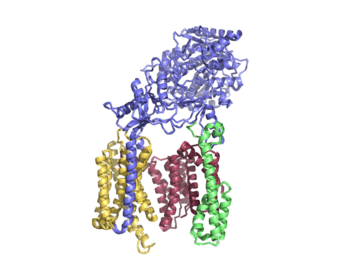Gamma Secretase
Introduction
Background
Gamma Secretase is a transmembrane aspartate protease. It catalyzes peptide bond hydrolysis of type I integral membrane proteins such as Notch, APP, and various other substrates. It recognizes and catalyzes the reaction with its substrate using 3 residue segments. These substrates generate amyloid-β (Aβ). This product is important for various neural processes, and it is well known for its Implications with Alzheimer’s disease (AD). This has made gamma secretase a popular drug target, specifically using gamma secretase (GS) inhibitors. However, due to the nature of gamma secretase having various neural functions, there are dangerous side effects when it is inhibited.
Overall Structure
20 transmembrane components (TMs)
4 subunits
Nicastran (NCT),Anterior pharynx-defective 1 (APH-1), Presenilin (PS1), Presenilin enhancer 2 (PEN-2), and4 phosphatidylcholines stabilize structure (interface between PS1 and PEN-2; APH-1 and PS1; APH-1 and NCT)
5A63 Article
practice
Structural highlights
Substrate Structure
Made of an N-terminal loop, a transmembrane helix, and a C-terminal β-strand
Lateral diffusion to enter enzyme
TM helix anchored by hydrogen bonds
Unwinding model
β-strand used for substrate recognition
Lid Complex
Active Site
Relevance
APP build up leads to Amyloid plaques in brain
Inhibition of γ-secretase could be potential AD treatment
Location of majority of mutations
Over 200 mutations that cause AD
AD mutations heavily target interface between PS1 and APP
Important to look at differences between substrates

